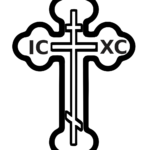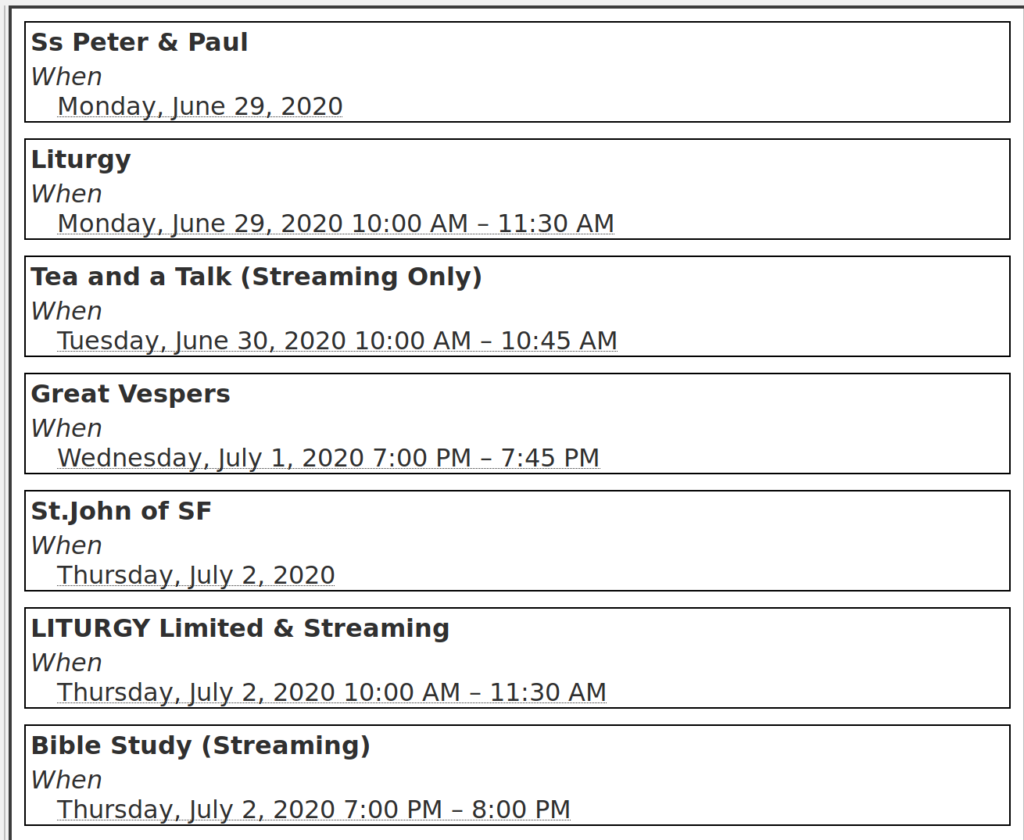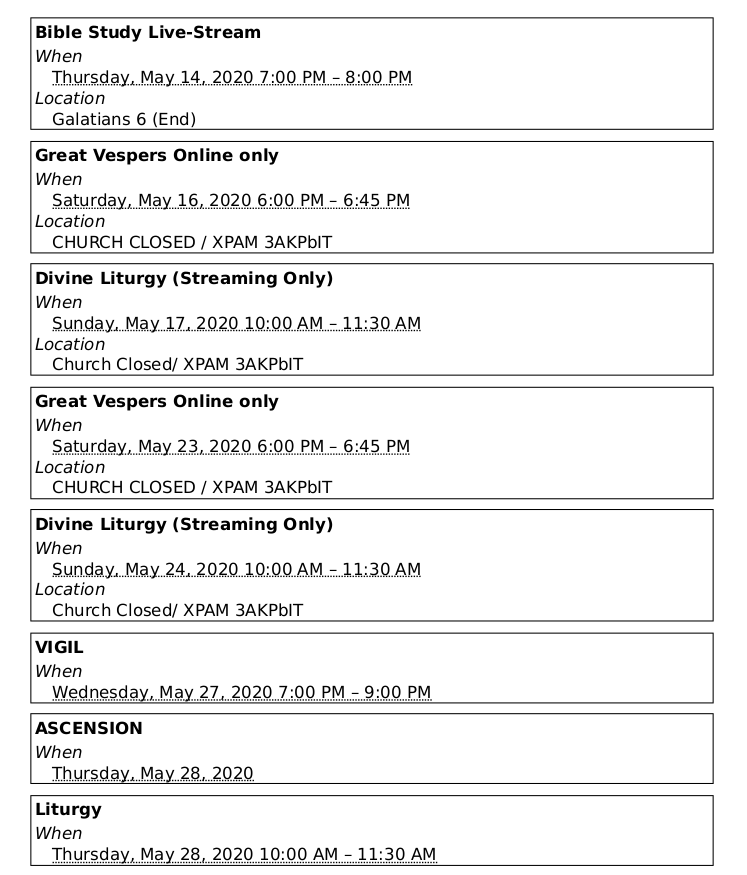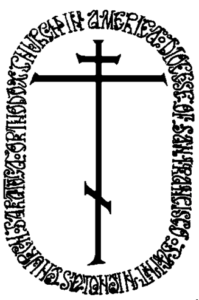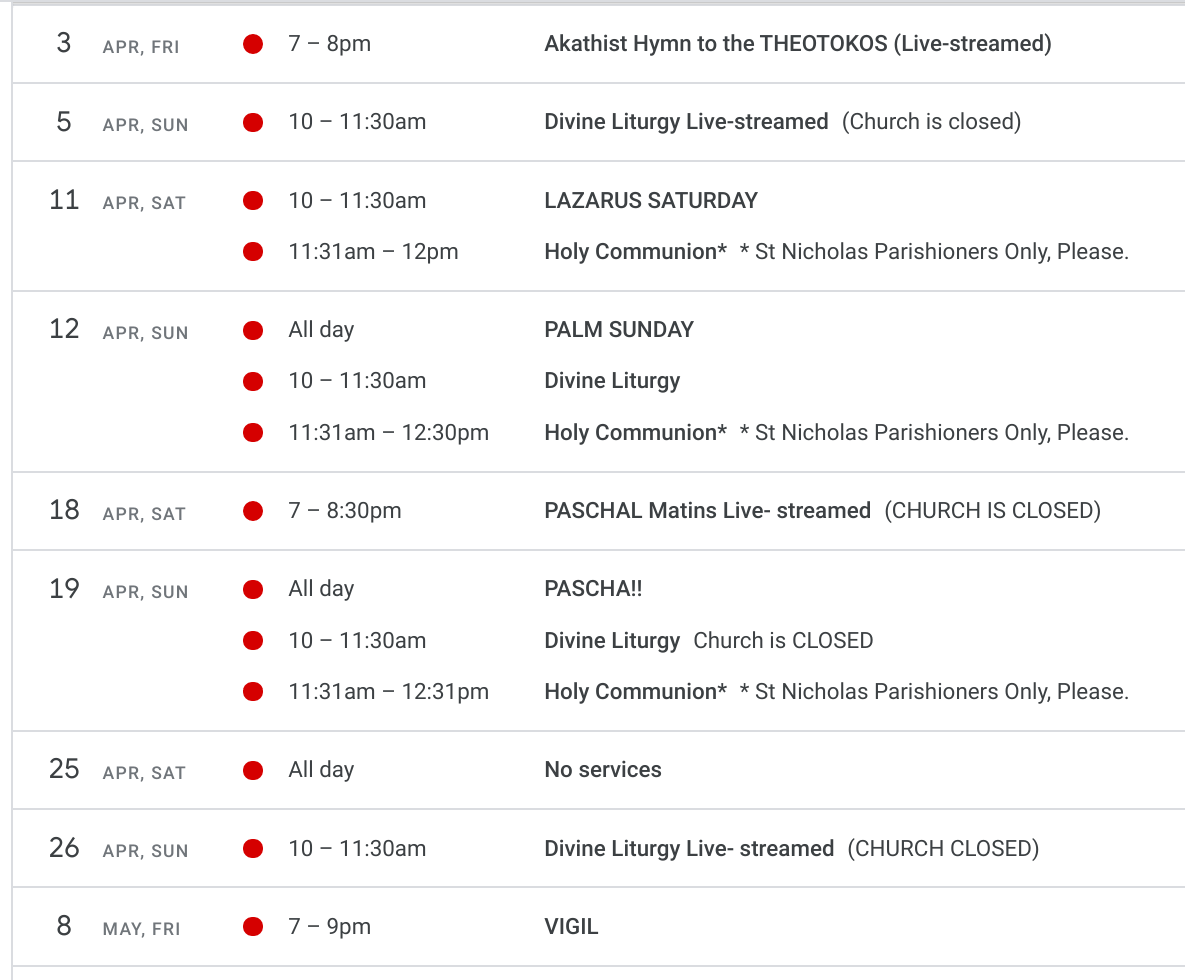
Focus on the Faith: A Sermon on the Transfiguration
In the Name of the Father and of the Son and of the Holy Spirit.
Today our Lord’s human nature was transfigured by the Holy Spirit, proceeding from the Father, Whose voice witnessed to the Son’s divine nature. We are perhaps reminded of another Feast of the Church taken from the Holy Scriptures, where the divinity of Christ was also witnessed to by the Father and the Spirit proceeding from the Father – Theophany, the Baptism of Christ. Both these feasts have a great prominence in our Church, which has been lost outside Her, where people do not believe in the words of the Holy Scripture, that the Holy Spirit proceeds from God the Father alone. This Feast shows us firstly that the human and divine natures of Christ are united in One Person, secondly that therefore there is no unity without the Holy Spirit, and thirdly that our Saviour is Lord over Life and Death, for Moses, who died, worships Him, and Elijah, who did not die, also worships Him.
Today, however, I would like to point out an aspect of this Feast which is often overlooked: Mt Tabor, the ‘mountain’ where the Transfiguration occurred. This Mt Tabor is for us a figure of repentance. We note that, like the disciples, in order for us to see the transfiguration or to hope to be transfigured ourselves, we will first have to climb up, to mount, from our present condition. Otherwise any transfiguration or change for the better in our lives is impossible.
Now it is interesting that pilgrims who have been blessed to go to Mt Tabor and their photographs show us that Mt Tabor is not a mountain at all. It is rather a long, sloping hill with many obstacles, rocks and boulders, in the path of those who ascend it. And our transfiguration or salvation is like Mt Tabor. However hard we try, we will not be guaranteed salvation through a swift if arduous climb today. Salvation takes a lifetime, it is a long climb up a long slope, which is why the Lord gives most of us so long to live. Salvation is a long struggle which requires determination and perseverance, patient long-suffering. Our spiritual progress, then, is not sudden and dramatic. And there are many obstacles in our path in our daily struggle. To pick up our prayerbooks in the morning and again in the evening is a struggle and there are always obstacles in our path to even this: meals to prepare, trains to catch, phones that ring. Church life is indeed made up of little sacrifices, obstacles to overcome. There are prayers to say, fasts to be kept, a donation to be made, the clean-up to be done, flowers bought, the church cleaned, a choir rehearsal to go to, a vigil service to attend, a confession prepared.
As we come now towards the end of the Church’s Year, we may well ask ourselves what sacrifices have we made since this Feast last year? How far have we ascended up our own Mt Tabor? How have we changed, improved, over this last year? What have we done to lead a better life since then? How have we treated the poor, the homeless? What have we given God that we did not give Him before? It is this that we call progress: in what way am I a better Orthodox Christian than I was a year ago?
In our faith we are called to struggle daily, whatever the rocks or boulders in our way, whether they are pride or selfishness, lust or discouragement, envy or judging of others, we have to struggle to ascend our personal Mt Tabor, we have to fight for our personal transfiguration. That is why it is so important to come to confession and communion. If we do not do this, then the Church will move away from us. For we can both go up and go down a slope. We can spiritually progress, but we can also spiritually regress. We can be transfigured by the love of God or we can be disfigured by the love of sin. And like progress, regress is not sudden and dramatic, regress too is a slope, as we say, a slippery slope. Let us therefore take heed and give God what He really wants from us – our hearts and minds spiritually progressing. Amen. (Orthodox England)
From the Fathers
“No one is more blessed than the apostles, and especially these three, who even in the cloud were counted worthy to be under the same roof with the Lord. But if we desire it, we also shall behold Christ, not as they did back then on the mountain, but in far greater brightness. For He shall not appear like this hereafter. Back then, in order to spare His disciples, He revealed only so much of His brightness as they were able to bear; hereafter He shall come in the very glory of the Father, not with Moses and Elias only, but with the infinite host of the angels, with the archangels, with the cherubim, with those infinite tribes, not having a cloud over His head, but even heaven itself…”
St John Chrysostom (On the Transfiguration)
“Finally when blessed Mary having completed the course of this life, and was to be called from the world, all the Apostles gathered to her house from their different regions. And when they had heard that she was to be taken from the world, together they kept watch with her; a lo, the Lord Jesus came with His angels. Taking her soul, He gave it the the Archangel Michael and withdrew. At dawn the Apostles raised her body with a pallet and they placed it in a vault and they guarded it awaiting the coming of the Lord. And lo, a second time the Lord stood by them and he ordered the holy body to be taken and borne to Paradise; there having rejoined the soul exultant with His elect, it enjoys the good things of eternity which shall know no end.”
St Gregory of Tours (On the Dormition)
Orthopraxis: Why a Fast for Dormition?
by Reader Daniel Manzuk
It would be a gross understatement to say that much has been written about the Feast of the Dormition of the Theotokos. Yet very little has been written about the fast that precedes it.
Every Orthodox Christian is aware and generally knows the reason behind the fasts for Pascha and Christmas. But while they may know of the Dormition Fast, few follow it, and more than a few question why it is there, neither knowing its purpose. First, given the pervasive misunderstanding of the purpose of fasting itself, a refresher on its purpose is always a good idea. There is a perception that we should fast when we want something, as though the act of fasting somehow appeases God, and seeing us “suffer” gets Him to grant our request. Nothing can be further from the truth. It is not our fasting that pleases God, it is the fruits of our fast (provided we fast in the proper mind set, and do not merely diet) that please Him. We fast, not to get what we want, but to prepare ourselves to receive what God wants to give us. The purpose of fasting is to bring us more in line with another Mary, the sister of Lazarus, and away from their sister Martha, who in the famous passage was “anxious and troubled about many things.” Fasting is intended to bring us to the realization of “the one thing needful.” It is to help us put God first and our own desires second, if not last. As such it serves to prepare us to be instruments of God’s will, as with Moses in his flight from Egypt and on Mt. Sinai, as well as our Lord’s fast in the wilderness. Fasting turns us away from ourselves and toward God. In essence it helps us become like the Theotokos, an obedient servant of God, who heard His word and kept it better than anyone else has or could.
So why do we fast before Dormition? In a close-knit family, word that its matriarch is on her deathbed brings normal life to a halt. Otherwise important things (parties, TV, luxuries, personal desires) become unimportant; life comes to revolve around the dying matriarch. It is the same with the Orthodox family; word that our matriarch is on her deathbed, could not (or at least should not) have any different effect than the one just mentioned. The Church, through the Paraklesis Service, gives us the opportunity to come to that deathbed and eulogize and entreat the woman who bore God, the vessel of our salvation and our chief advocate at His divine throne. And as, in the earthly family, daily routines and the indulgence in personal wants should come to a halt. Fasting, in its full sense (abstaining from food and desires) accomplishes this. Less time in leisure or other pursuits leaves more time for prayer and reflection on she who gave us Christ, and became the first and greatest Christian. In reflecting on her and her incomparable life, we see a model Christian life, embodying Christ’s retort to the woman who stated that Mary was blessed because she bore Him: blessed rather are those who hear His word and keep it. Mary did this better than anyone. As Fr. Thomas Hopko has stated, she heard the word of God and kept it so well, that she of all women in history was chosen not only to hear His Word but give birth to it (Him). So while we fast in contemplation of her life, we are simultaneously preparing ourselves to live a life in imitation of her. That is the purpose of the Dormition Fast.
“When the assumption of thine undefiled body was being prepared, the Apostles gazed on thy bed, viewing thee with trembling. Some contemplated thy body and were dazzled, but Peter cried out to thee in tears, saying, I see thee clearly, O Virgin, stretched out, O life of all, and I am astonished. O thou undefiled one, in whom the bliss of future life dwelt, beseech thy Son and God to preserve thy people unimpaired.”
(Sticheron after the Gospel, Matins)
Daniel Manzuk is a reader at the Church of the Virgin Mary in Alsip, IL.
Lives of Saints
Choir Director’s Corner: The Paraklesis during the Dormition Fast
Many of you remember that in previous years, we frequently (if not daily) met in the temple in the evening during the fast and prayed the Paraklesis to the Most Holy Theotokos. The center of this service is the same canon that we read as part of the rule of preparation for Holy Communion from the prayer book, but with extra prayers, a gospel, and other beautiful verses.
You can do this service in your prayer corner at home! This is an excellent way, in addition to the fast, to prepare for the feast of Dormition.
Here is the text of the service to download and print or place in your tablet device.
If you don’t know the melodies, you can just “plainchant” it on a single note, or read it silently.
Here is a YouTube video by Eikona that you can pray along with, and learn some of the Greek melodies:
Upcoming Events
Upcoming events this month (Events are subject to change! see the online calendar for updates or the attached PDF for more info)
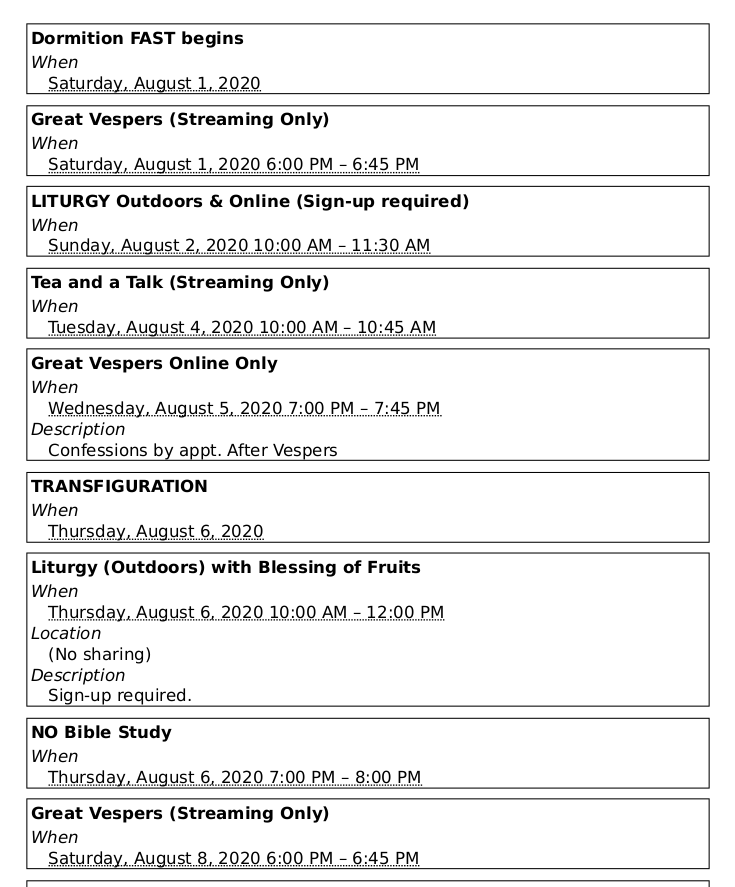

 The Fourth of July is always a time for celebration in our land. It is a chance for family and friends to gather together for barbeques, outdoor activities, and fireworks. It is common practice in our churches to offer a Prayer Service, a Molieben of Thanksgiving at this time, and here, in the Pacific Central Deanery, it has been the custom for nearly 100 years to make a pilgrimage to Fort Ross and offer the Divine Liturgy there at the chapel in thanksgiving to God for this wonderful country of ours. But this year will be an exception. There will be NO Liturgy on the 4th of July at the Fort! COVID19 has seen to it that our get-togethers, fully open divine services, and pilgrimages are out! What a disappointment. But we can still take time out from our holiday to focus more carefully on the deeper meaning of the “Glorious Fourth.”
The Fourth of July is always a time for celebration in our land. It is a chance for family and friends to gather together for barbeques, outdoor activities, and fireworks. It is common practice in our churches to offer a Prayer Service, a Molieben of Thanksgiving at this time, and here, in the Pacific Central Deanery, it has been the custom for nearly 100 years to make a pilgrimage to Fort Ross and offer the Divine Liturgy there at the chapel in thanksgiving to God for this wonderful country of ours. But this year will be an exception. There will be NO Liturgy on the 4th of July at the Fort! COVID19 has seen to it that our get-togethers, fully open divine services, and pilgrimages are out! What a disappointment. But we can still take time out from our holiday to focus more carefully on the deeper meaning of the “Glorious Fourth.”